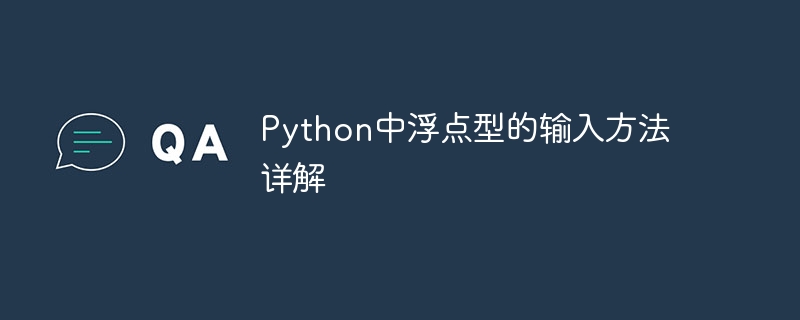

Detailed explanation of floating-point input methods in Python
In Python programming, we often need to obtain input data from the user. When it comes to floating point data, how to accurately read and process user input becomes critical. This article will introduce the floating-point input method in Python in detail and provide specific code examples.
1. Use the input() function to obtain input
The built-in input() function in Python can be used to obtain user input data. But it should be noted that the input() function will process the data entered by the user as a string type by default, not a floating point type. Therefore, we need to perform data type conversion.
The following is a sample code:
value = input("请输入一个浮点数:")
float_value = float(value)
print("您输入的浮点数是:", float_value)The above code first obtains the user's input through the input() function and saves it in the variable value. Then, use the float() function to convert the value to floating point data, and save the result in the variable float_value. Finally, the floating point number entered by the user is output through the print() function.
2. Exception handling
When using the input() function to obtain user input, you need to consider that the user may enter illegal floating point numbers, such as strings or other data that cannot be converted to floating point types. . To avoid program errors in this situation, we can use exception handling mechanisms.
The following is a sample code:
while True:
try:
value = float(input("请输入一个浮点数:"))
print("您输入的浮点数是:", value)
break
except ValueError:
print("您输入的不是合法的浮点数,请重新输入!")The above code uses a while loop to continuously try to obtain legal floating point input. In the try block, first obtain the user's input through the input() function, and try to convert it into floating point data using the float() function. If the conversion is successful, the floating point number entered by the user will be output and the loop will be jumped out. If the conversion fails, that is, the user enters an illegal floating-point number, a ValueError exception will be triggered. The program will execute the code in the except block and use a while loop to continue waiting for legal input.
3. Use regular expressions
Regular expression is a powerful tool for matching strings. When we need to perform more complex validation on user input, we can use regular expressions to determine whether the input is a legal floating point number.
The following is a sample code:
import re
pattern = r'^[-+]?[0-9]*.?[0-9]+([eE][-+]?[0-9]+)?$'
while True:
value = input("请输入一个浮点数:")
if re.match(pattern, value):
float_value = float(value)
print("您输入的浮点数是:", float_value)
break
else:
print("您输入的不是合法的浮点数,请重新输入!")The above code first imports the re module in Python in order to use the regular expression function. Then, a regular expression pattern is defined to match legal floating point numbers. Next, get the user input in a while loop and match it using the re.match() function. If the match is successful, it is converted to a floating point number and output, otherwise the user is prompted to re-enter.
Summary
This article introduces the floating-point input method in Python and provides specific code examples. We can use the input() function with data type conversion to implement simple floating point number input. At the same time, in order to handle illegal data that users may enter, you can use exception handling mechanisms or regular expressions to perform more complex verification. I hope this article will be helpful to you when using Python to process floating point input.
The above is the detailed content of In-depth analysis of floating point number input methods in Python. For more information, please follow other related articles on the PHP Chinese website!




